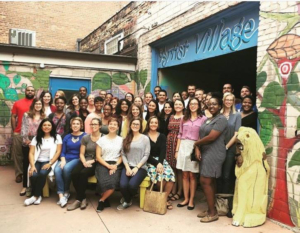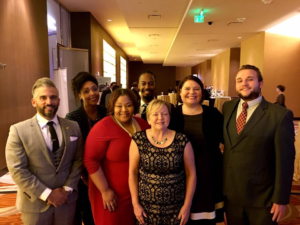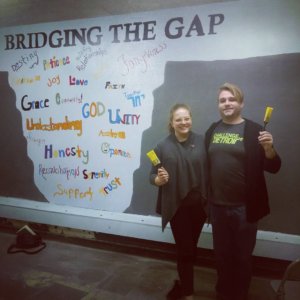Tell us about living in Detroit. What neighborhood do you live in and what makes your neighborhood unique?
I live in Midtown, in an area many know as the Cass Corridor. Midtown is actually a collection of neighborhoods including the corridor, Brush Park, Art Center, as well as the campuses of Wayne State University, the College for Creative Studies, and the Detroit Medical Center, to name a few. There is a great collection of new and old restaurants, including Traffic Jam and Snug, The Whitney, Hopcat, and Gus’ World Famous Fried Chicken. There’s also plenty of great watering holes, like The Old Miami, Bronx Bar, and Motor City Brewing Works. However, my favorite part of Midtown is the museums, especially the Detroit Institute of Arts and the Charles H. Wright Museum of African-American History. We also have amazing festivals like Dally in the Alley and Noel Night that draw thousands of people from around the region to enjoy all that Midtown has to offer. Long story short, there is something for everyone to enjoy!
What have you learned from Challenge Detroit so far?
 Detroit is a place not easily explained or understood. It is a place that has thrived despite its challenges. It represents the best and worst effects of a capitalist society. It is a testament to the will of a people to create, innovate, and rediscover themselves and their city every single day. There was a time I saw Detroit through rose-colored glasses. That day has long past. Now I see opportunity and potential in many of Detroit’s greatest challenges, which can be tackled by utilizing her greatest assets. The greatest of those assets is without question her people. 21st century Detroit will be defined by how she cares for her people, especially those with the fewest opportunities and resources currently at their disposal. It will be the defining focal point of the foreseeable future.
Detroit is a place not easily explained or understood. It is a place that has thrived despite its challenges. It represents the best and worst effects of a capitalist society. It is a testament to the will of a people to create, innovate, and rediscover themselves and their city every single day. There was a time I saw Detroit through rose-colored glasses. That day has long past. Now I see opportunity and potential in many of Detroit’s greatest challenges, which can be tackled by utilizing her greatest assets. The greatest of those assets is without question her people. 21st century Detroit will be defined by how she cares for her people, especially those with the fewest opportunities and resources currently at their disposal. It will be the defining focal point of the foreseeable future.
Tell us about your host company and your role in the organization.

I work as an Experience Coordinator at the Detroit Experience Factory. DXF is a non-profit that runs a brick-and- mortar Detroit Welcome Center, provides a host of tours throughout the city, and puts together informational materials to help individuals navigate around. Our goal is to connect locals and visitors with Detroit’s people, places, and projects. My role as an Experience Coordinator is planning and giving tours, which include walking tours, bus tours, bar tours, scavenger hunts, strolling suppers, and a combination of any of those offerings. We give tours for one person all the way up to over 200 people. My job is to work with clients, tour guides, and community partners to ensure an efficient, affordable, and fun experience for our guests.
What kind of impact do you hope to have with your host company and within the city?
The Detroit Experience Factory is continuing to expand our team and reach throughout the city. My goal is to grow with DXF, helping to expand our corporate partnerships with other large corporations headquartered in Greater Downtown Detroit. There are many new people from outside of Southeast Michigan, and even some from this region, just beginning their journey to understanding Detroit. My goal as a tour guide and staff member at DXF is to share the triumphs and challenges currently facing Detroit. This hopefully creates more respectful, curious, and service-oriented newcomers. I want Detroit to be a city for everyone, but especially for those that have lived here for most or all of their lives, through the ebb and flow of an ever-changing city.
What are you most looking forward to as you continue your fellowship year?
 2016 was a great year for me in landing my dream job at DXF and my dream fellowship with Challenge Detroit. However, I dealt with some difficult personal struggles that made it tough to truly thrive in these roles. My goal for 2017 is to tackle those personal struggles head on, be more present with DXF and CD, and continue to learn and grow as a member of Detroit. Cultural competency was a big focus for me in 2016, growing up 18 years of my life in a whitewashed, almost culture-less suburban community. My main focus was learning more about the African-American community in Detroit. In 2017, I would like to begin learning more about other communities in Southeast Michigan, including the Hispanic, Arabic, and Jewish communities.
2016 was a great year for me in landing my dream job at DXF and my dream fellowship with Challenge Detroit. However, I dealt with some difficult personal struggles that made it tough to truly thrive in these roles. My goal for 2017 is to tackle those personal struggles head on, be more present with DXF and CD, and continue to learn and grow as a member of Detroit. Cultural competency was a big focus for me in 2016, growing up 18 years of my life in a whitewashed, almost culture-less suburban community. My main focus was learning more about the African-American community in Detroit. In 2017, I would like to begin learning more about other communities in Southeast Michigan, including the Hispanic, Arabic, and Jewish communities.
What do you envision for Detroit 10 years from now?
As stated earlier, the future of 21 st century Detroit will be defined by how she treats her people, especially those who currently have the least access to resources. Equitable development is the key here. I have been learning about the difference of equality versus equity, and that’s hugely important when you talk about redeveloping an urban area with a history of division and inequity. I am glad and hopeful because I believe we are having this conversation earlier than many urban areas that have redeveloped with little if any concern for the most vulnerable citizens. In my ideal future for Detroit, our education system would be available and work for every person. There would be options and trajectories, and individuals could be in charge of their education and subsequently their future. There would be no homeless individuals, no individuals facing food insecurity, water shut-offs, health care gaps, or any other service that should be considered a basic human right in a 21 st century city. We must first meet the challenges of the 20th century before we can begin to tackle the challenges of the 21 st century. In fact, we may very well find some of the latter by solving the former. Detroit can and should be a great city again. But it will never be great again before the quality of life is valued and improved for every citizen.
To hear a bit more about Ian’s year so far as a Fellow in Detroit and what he is looking forward to in 2017 check out his spotlight video below!
